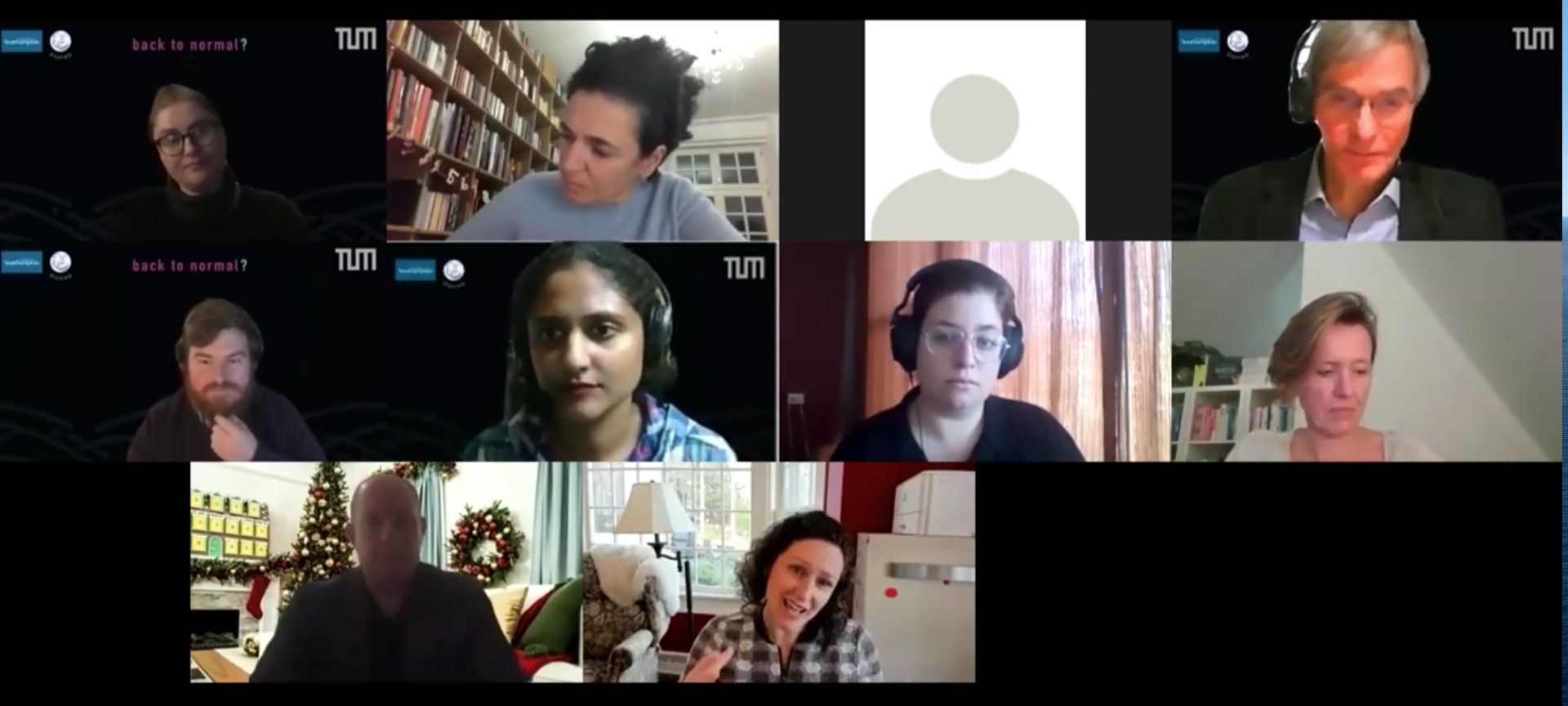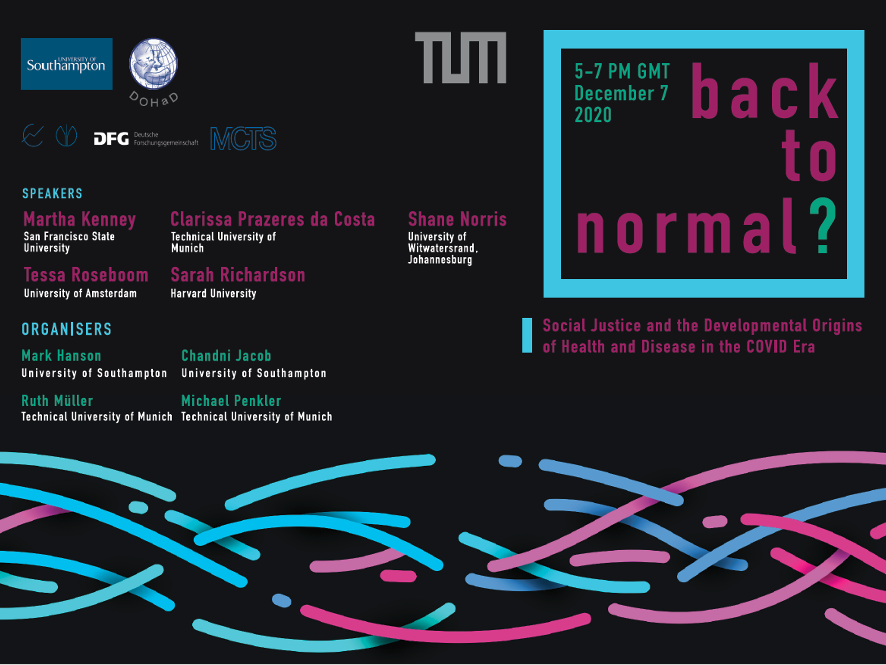Although the COVID-19 pandemic is far from over, many countries are resuming economic and social activities, with the goal of returning to some semblance of ‚normality‘. But how should this new normal look like? This was the topic of an interdisciplinary webinar entitled “Back to Normal? Social Justice and the Developmental Origins of Health and Disease in the COVID Era”, which took place on December 7, 2020. The webinar was hosted by the Munich Center for Technology in Society (MCTS) at the Technical University of Munich in collaboration with the International Society for Developmental Origins of Health and Disease as well as the University of Southampton.
The webinar was the result of a longstanding collaboration between Mark Hanson and Chandni Jacob from the Institute for Developmental Sciences (IDS) at the University of Southampton and Ruth Müller and myself from the MCTS. The IDS is a leading center in the Developmental Origins of Health and Disease (DOHaD) field. This biomedical research field is based on the hypothesis that many chronic diseases have developmental origins (Gluckman, Buklijas, & Hanson, 2016). DOHaD traces how environmental influences like nutrition, stress or toxic exposure during susceptible periods (such as in utero or the first two years of life) can condition the developing organism in ways that make it more likely to develop disease decades later in adulthood. DOHaD has received interest from Science and Technology Studies (STS) scholars because it promises to open up a ‘biosocial perspective’ that considers how social factors shape biological processes and that allows bringing questions of social justice into biomedical thinking and practice (Müller et al., 2017). At the same time, some STS scholars have cautioned against reductionist tendencies in DOHaD that might lead to focusing predominantly on maternal factors and thus re-produce gendered stereotypes that contribute to ‘blaming the mother’ (e.g., Richardson et al., 2014).
In this context, the webinar was part of our ongoing interdisciplinary collaboration with DOHaD researchers on how STS perspectives can contribute to socially responsible DOHaD research and policy translations (Penkler et al., 2019). It brought together in equal parts researchers from DOHaD and STS to discuss what social justice questions arise in the present pandemic. One of our departing premises was that the current pandemic has dramatically highlighted how social inequalities are tied to unequal vulnerabilities, with disadvantaged groups bearing the biggest social, health and economic burden. While associations of adverse effects with so-called ‘pre-existing’ conditions like obesity and type 2 diabetes have been widely reported, it is important to highlight how many of these conditions have their roots in underlying social inequalities. At the same time, the economic and social effects of the current crisis are set to exacerbate existing inequalities, with potentially long-term health consequences as women and children are groups that, while not being at high risks of adverse health outcomes from COVID-19, are particularly affected by the pandemic’s economic and social impact (Penkler et al., 2020).
After an introduction by Mark Hanson and Ruth Müller, Martha Kenney from the San Francisco State University delivered the first presentation on “Social Justice and Recovery from COVID-19”. In her presentation, she pointed out that a focus on so-called ‘pre-existing conditions’ like obesity runs danger of losing sight of underlying social inequalities and of locating risk and responsibility primarily at the level of the individual. This could reinforce a eugenic logic that separates healthy ‘us’ from unhealthy ‘others’ who are blamed for their own ill-health. Instead, it is important to highlight and address the structural factors that drive health disparities. DOHaD insights on how adverse conditions during early life can increase the risk for later life disease accord with social science insights how social inequalities and structures of inequality become embodied, shaping health outcomes across the life course and generations. Therefore, social justice is fundamental to promoting health in society, and resilience to health emergencies requires systematic rather than individual change. In this context, Kenney ended her talk with recommendations for strengthening the social justice impact of DOHaD research: Collaborating with STS scholars and other social scientists can help design studies that account for both biological and social complexity. DOHaD researchers should further identify concerns and research questions that are relevant to the communities being studied. Additionally, she recommends to focus DOHaD research on investigating structural causes of inequality instead on lifestyle and individual behaviors, and to conduct research on how to promote community resilience instead of focusing mainly on the negative outcomes of adverse early life conditions.
Tessa Roseboom from the University of Amsterdam delivered a talk that was deftly named “Using the ‘shit’ of the COVID-19 crisis as a fertilizer for the soilbase to build a sustainable society for future generations”. Roseboom’s work has focused on the long-term health consequences of prenatal exposures during the Dutch Hunger Winter, which was a famine caused by a German embargo during World War II (Roseboom, de Rooij, & Painter, 2006). Her studies have provided evidence for how adverse conditions during early childhood can have severe long-term impacts on the risk for cardiovascular disease as well as on cognitive function in later life. According to Roseboom, this shows how fundamental early life is for later wellbeing and for the possibility of children reaching what she calls their ‘full potential’. In this context, providing adequate conditions for children to grow and develop is fundamentally children’s rights issue, as captured by the United Nation’s Declaration of the Right of the Child. This is especially pertinent in the current crises, where children and families are particularly affected by increases in domestic violence, a deteriorating economy, increased stress and food insecurities. Given the possible long-term effects, we need to invest in early human development now to lay the foundation for a more just and sustainable future for all.
In her talk, Sarah Richardson reported findings from Harvard University’s GenderSci Lab COVID Project, which show how social factors mediate and drive sex disparities in COVID-19 outcomes. For example, gender-related behavioral factors influence the uptake of preventive practices (e.g., men are less likely to wear masks). Structural aspects are important, too: Gender differences in occupation effectively lead to a gender-segregated structure of exposure, with men being more likely to work in fields that come with a higher risk of exposure. Together, these findings highlight how context matters for interpreting disparities in health and for explaining sex differences that were originally seen as primarily biological in origin (Shattuck-Heidorn, Reiches, & Richardson, 2020). Richardson argued that this provides an important lesson for DOHaD research. The C-19 pandemic will offer an opportunity to study the long-term effects of prenatal and early life exposures. This corresponds to a well-established research approach in DOHaD to work with so-called ‘natural experiments’. However, such study designs run the risk of reducing complexity, as events like the Dutch Hunger Winter or the current pandemic are incredibly complex. The idea that we can study these events at the level of the body is a move that potentially translates modest and uncertain findings into very bold biosocial theories that often locate causality and agency in the intrauterine period. Such an approach risks collapsing very different scales (from the social to the molecular), levels of biological and social analysis as well as different time scales and histories into very specific claims about biological processes like neurocognitive development. According to Richardson, these claims produce potentially very compelling narratives, but they need to be critically questioned. In investigating the long-term effects of the C-19 pandemic, DOHaD researchers should be aware that we are dealing with very complex social factors and that we are reasoning about risk under conditions of uncertainty and large gaps in the data.
In the final presentation, Shane Norris from Wits University spoke on global health and justice perspectives raised by the current pandemic, with a specific focus on South Africa. South Africa had initially a very rapid and successful response to COVID-19 that ended in preventing many hospitalizations. However, this response had also very uneven effects on its population. In particular, it severely disrupted the informal economy on which many South African communities rely. The substantial economic fallout has disproportionally affected women, who work to a larger extent in the informal economy. This is one example of how multiple inequalities in a very unequal society intersect and reinforce each other, with strong intergenerational effects. According to Norris, we need to pay attention to these inequalities and narrow the gap if we want to achieve better health for everyone. Bringing a better understanding of the social determinants of health and disease to the DOHaD literature is absolutely critical in this context.
In sum, the presentations and the following lively discussion revealed substantial shared “matters of care” (Puig de la Bellacasa, 2011) between DOHaD and STS scholars. Speakers and participants from both fields shared concerns with how to build a more equitable world that provides better health for everyone. There were also some points for debate: for example, some discussants pointed out the danger of deterministic narratives that describe certain population groups as biologically damaged due to adverse experiences in early life, arguing that this could have eugenic implications. But overall, the webinar provided a strong example for how biomedical researchers and social scientists can engage in mutual and symmetric discussions on how to promote the social justice impact of health research. The next step, from my perspective, will be to further explore how to turn these discussions into actual interdisciplinary collaborations that for example include STS scholars into the design and implementation of DOHaD research studies.
You can find a recording of the webinar here: https://youtu.be/6xgOlVYeufo
References
Gluckman PD, Buklijas T and Hanson MA (2016) The Developmental Origins of Health and Disease (DOHaD) concept: past, present, and future. In Rosenfeld CS (ed) The epigenome and developmental origins of health and disease. Boston, MA: Academic Press, pp. 1-15.
Müller R, Hanson C, Hanson M, Penkler M, Samaras G, Chiapperino L, Dupré J, Kenney M, Kuzawa C, Latimer J, Lloyd S, Lunkes A, Macdonald M, Meloni M, Nerlich B, Panese F, Pickersgill M, Richardson SS, Rüegg J, Schmitz S, Stelmach A and Villa, P-I (2017) The biosocial genome? Interdisciplinary perspectives on environmental epigenetics, health and society. EMBO Reports 18(10): 1677–1682.
Penkler M, Hanson M, Biesma RG and Müller R (2019) DOHaD in science and society: emergent opportunities and novel responsibilities. Journal of Developmental Origins of Health and Disease 10(3): 268-273.
Penkler M, Müller R, Kenney M and Hanson M (2020) Back to normal? Building community resilience after COVID-19. The Lancet Diabetes & Endocrinology 8(8): 664-665.
Puig de la Bellacasa M (2011) Matters of care in technoscience: assembling neglected things. Social Studies of Science 41(1): 85-106.
Richardson SS, Daniels CR, Gillman MW, Golden J, Kukla R, Kuzawa C and Rich-Edwards J (2014) Don’t blame the mothers. Nature 512: 131-132.
Roseboom T, de Rooij S and Painter R (2006) The Dutch famine and its long-term consequences for adult health. Early Human Development 82(8): 485-491.
Shattuck-Heidorn H, Reiches and Richardson SS (2020, June 24, 2020). What’s really behind the gender gap in Covid-19 deaths? New York Times.

